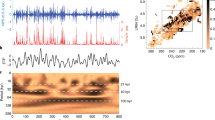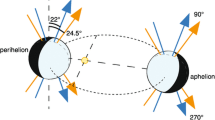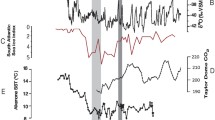Abstract
To study glacial termination and related feedback mechanisms, a continental ice dynamics model is globally and asynchronously coupled to a physical climate (atmosphere-ocean-sea ice) model. The model performs well under present-day, 11 kaBP (thousand years before present) and 21 kaBP perpetual forcing. To address the ice-sheet response under the effects of both perpetual orbital and CO2 forcing, sensitivity experiments are conducted with two different orbital configurations (11 kaBP and 21 kaBP) and two different atmospheric CO2 concentrations (200 ppmv and 280 ppmv). This study reveals that, although both orbital and CO2 forcing have an impact on ice-sheet maintenance and deglacial processes, and although neither acting alone is sufficient to lead to complete deglaciation, orbital forcing seems to be more important. The CO2 forcing has a large impact on climate, not uniformly or zonally over the globe, but concentrated over the continents adjacent to the North Atlantic. The effect of increased CO2 (from 200 ppmv to 280 ppmv) on surface air temperature has its peak there in winter associated with a reduction in sea-ice extent in the northern North Atlantic. These changes are accompanied by an enhancement in the intensity of the meridional overturning and poleward ocean heat transport in the North Atlantic. On the other hand, the effect of orbital forcing (from 21 kaBP to 11 kaBP) has its peak in summer. Since the summer temperature, rather than winter temperature, is found to be dominant for the ice-sheet mass balance, orbital forcing has a larger effect than CO2 forcing in deglaciation. Warm winter sea surface temperature arising from increased CO2 during the deglaciation contributes to ice-sheet nourishment (negative feedback for ice-sheet retreat) through slightly enhanced precipitation. However, the precipitation effect is totally overwhelmed by the temperature effect. Our results suggest that the last deglaciation was initiated through increasing summer insolation with CO2 providing a powerful feedback.
Similar content being viewed by others
Author information
Authors and Affiliations
Additional information
Received: 22 February 2000 / Accepted: 17 September 2000
Rights and permissions
About this article
Cite this article
Yoshimori, M., Weaver, A., Marshall, S. et al. Glacial termination: sensitivity to orbital and CO2 forcing in a coupled climate system model. Climate Dynamics 17, 571–588 (2001). https://doi.org/10.1007/s003820000134
Issue Date:
DOI: https://doi.org/10.1007/s003820000134




